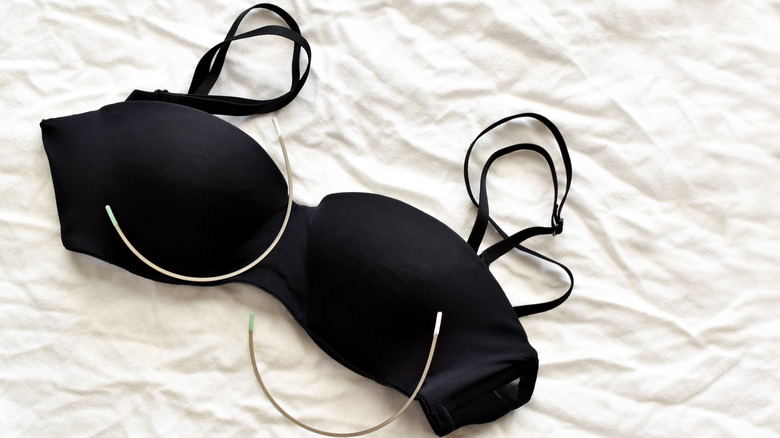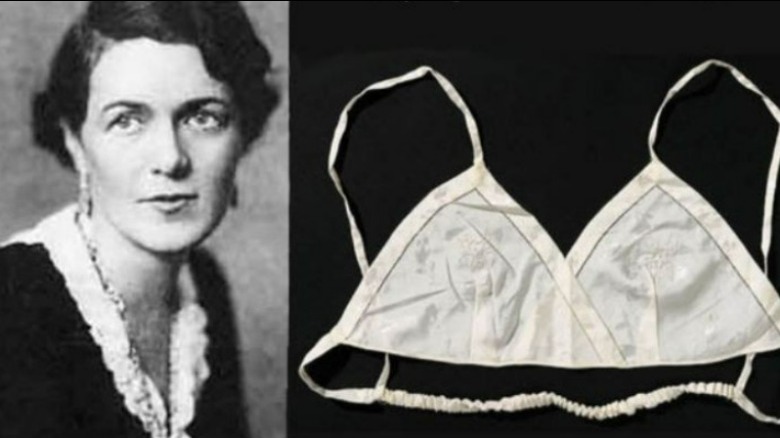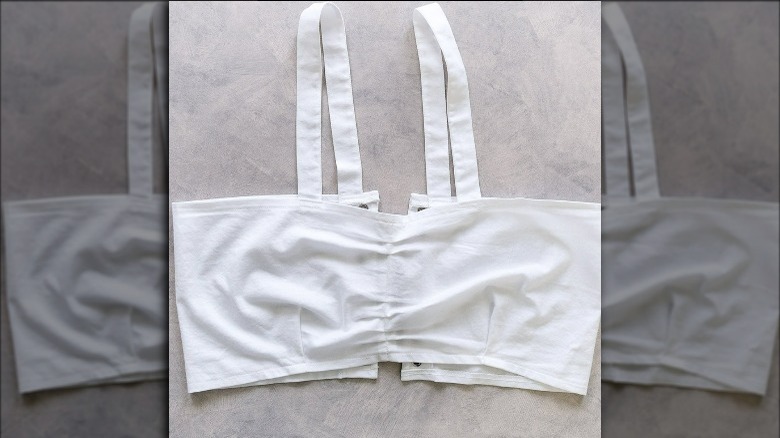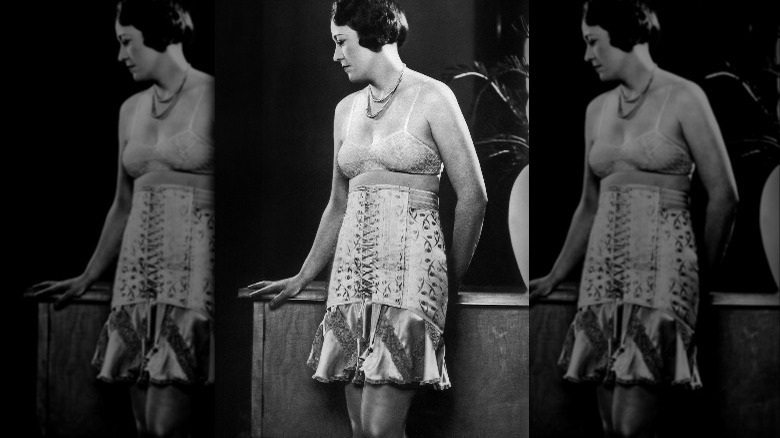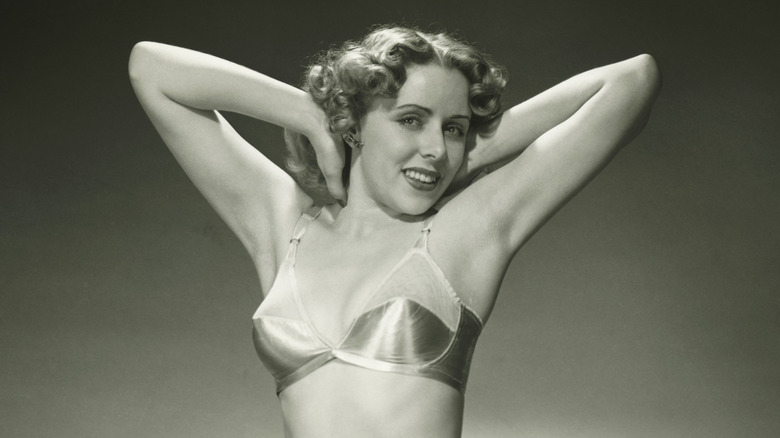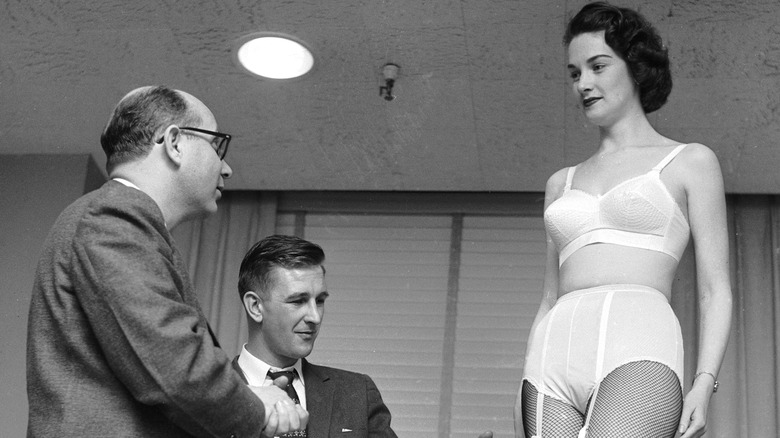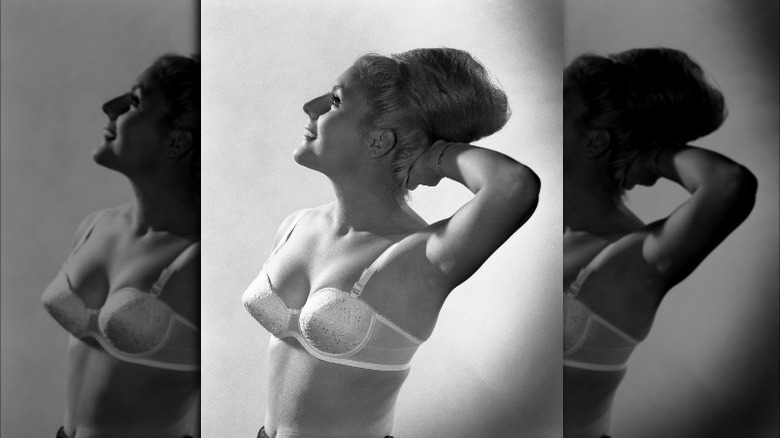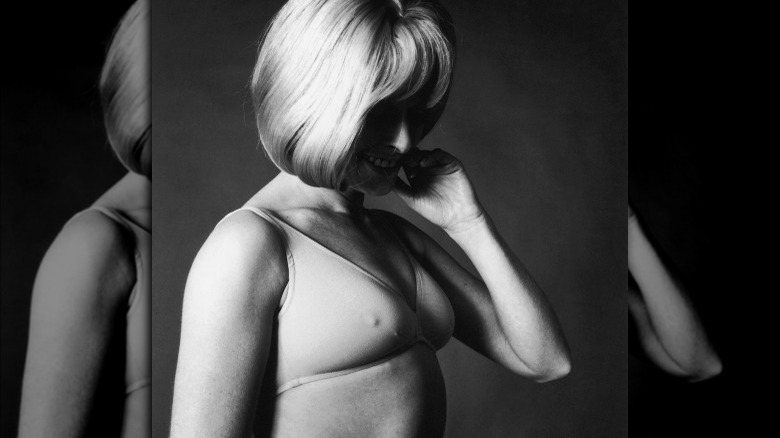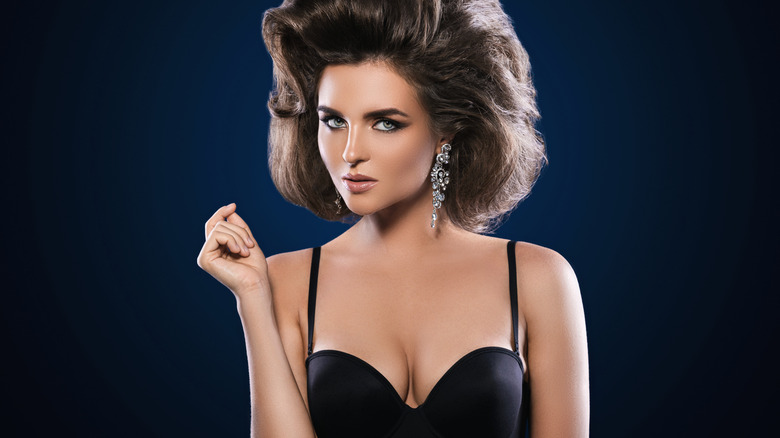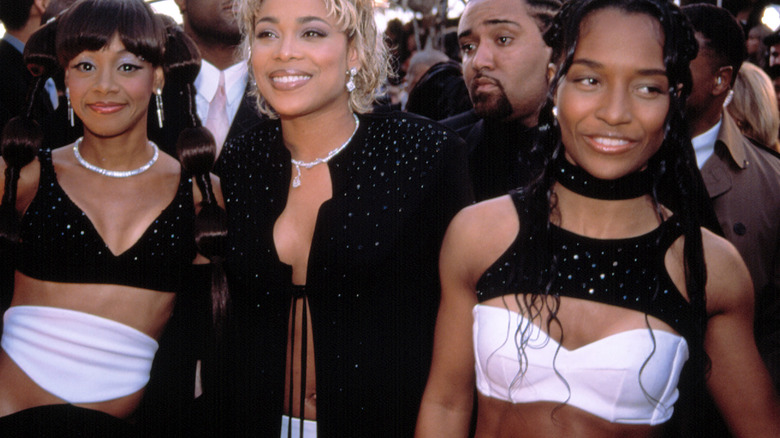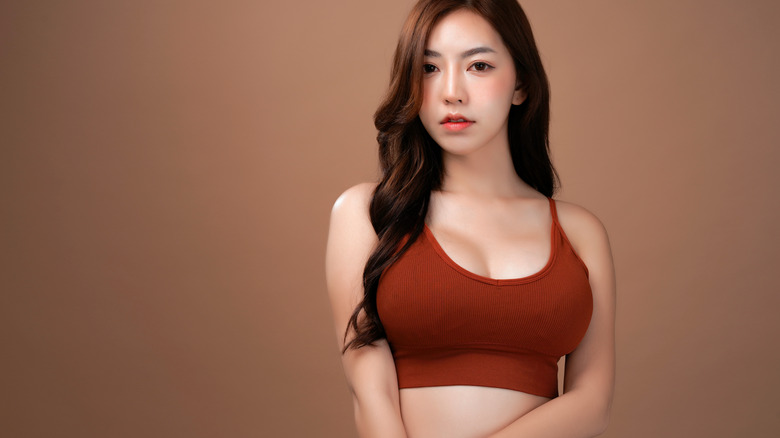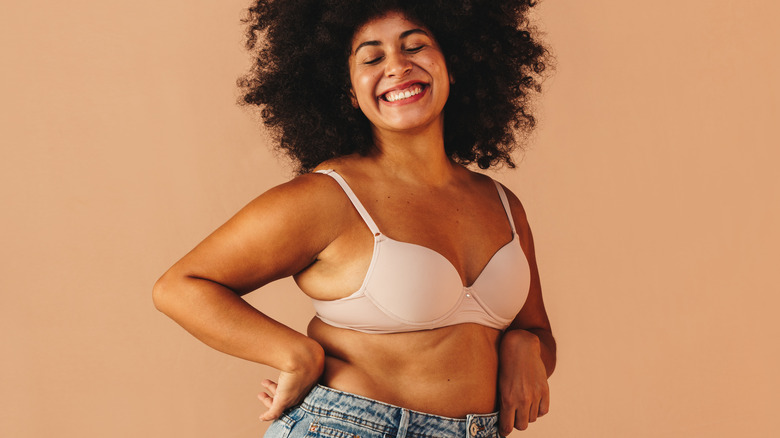100 Years Of Fashion: Bras
Strictly speaking, a bra is an undergarment, typically worn by women, that upholds and conceals the breasts. But is that all it is, really? The history of the bra would tend to suggest otherwise. The first bras to have been depicted in artwork, which dates back to the 14th century B.C., consisted of a band of fabric worn around the ribcage for the purpose of pushing the breasts up and making them appear more prominent, according to Pitt Rivers Museum. In other words, these bras weren't about supporting or covering the breasts so much as they were about propping them up and accentuating them.
More than likely, this has something to tell us about life in the Bronze Age. Moreover, bra fashion in any given time period reflects fashion in general, which, itself, is a product of economic and political realities, including then-prevailing views on the role of women in society. Even more specifically, the evolution of bra fashion tells a story, in parallel with the history books, of how women are viewed in any given time period, how they want to be viewed, and how they do, in fact, view themselves. Join us as we trace that story from a century ago when the bra was first officially "invented."
1910-1919: handkerchiefs and ribbons
Women have been fashioning makeshift breast coverings since the Bronze Age, but it took until the 20th century for someone to actually "invent" the bra. This is likely due to the enduring popularity of the corset, which began early in the Renaissance, per Hagen History Center. The corset, which constricted and emphasized the waist, also did the job of covering and supporting the breasts. Accordingly, the notion of a bra would have seemed redundant.
Starting in the second half of the 19th century, however, the corset began a long and gradual fall from favor. So too did the exaggerated hourglass body ideal, per FIT-NYC. Accordingly, by 1914, when New York City socialite Mary Phelps Jacobs secured the patent for her "backless brassiere," which she first started making herself in 1910, using two handkerchiefs sewn to a length of ribbon, there were enough women who longed to be free from all the hardware that comprised the corset to support what would soon become a burgeoning business, albeit not for Jacobs, per Interesting Engineering.
In 1915, Jacobs sold the patent to a predecessor company of lingerie giant Warner (via Connecticut History). Less than two years later, the U.S. government asked American women to support the war effort during World War I by not wearing corsets. In addition to freeing up two battleships worth of metal, Warner's revenues rose to $12.6 million by 1920 thanks, in no small part, to the popularity of the backless brassiere.
1920-1929: when modern bras were still in training
By 1929, the U.S. Patent and Trademark Office had registered nearly 200 patents for bras, per Greater Bay Area Costumer's Guild (GBACG), all of them aimed at improving Jacobs' original design and broadening its appeal. At the dawn of the 1920s, however, the modern bra was still in its infancy. For example, bras were available in only one size throughout much of the decade, per NPR. And bras from this time period weren't about support so much as about coverage and smooth lines. Women seeking bust support at this time tended not to seek it out in the form of commercially manufactured bras, but rather, by strapping down their breasts with fabric, per GBACG.
For the most part, female fashion of the 1920s, which tended toward the loose and flowy, dovetailed nicely with bras that didn't offer much in the way of support — like the white bralette shown above, which is sewn from a 1927 pattern. On the other hand, most of the bras sold in the 1920s were not yet white but rather pastel colors, per GBACG. More importantly to understand here is that it would have been more challenging to keep whites looking white back then because clothes washing wasn't nearly as advanced as it is today.
1930-1939: The modern bra as we know it takes shape
During the 1930s, curves were coming back — but not corset-shaped curves (via Bobbins & Bombshells). Rather, a more natural waist was prioritized, along with the appearance of little-to-no undergarments that was popularized by early Hollywood films, which were fairly liberal about showing actresses in their undergarments. Brassieres, which had finally come to be known as "bras," still tended to be wireless, but they were nevertheless beginning to offer more support and shaping, including separating the breasts into their own individual pockets, or, as they would eventually be called, "cups," per the National Museum of American History.
Although the women behind the company that eventually became Maidenform had been making bras with separate cups since the mid-1920s, according to Vintage Fashion Guild, the fact that bras were becoming widely available at retail stores during the 1930s exposed more women to this innovation. Other bra innovations that became widespread throughout the 1930s include adjustable elastic straps, padded cups, and the cup-size system, notes NPR. In addition, many bras now fastened in back with hooks and eyes, as they do now.
In terms of their look, bras from the 1930s tended to be plain, as opposed to lacy as they often are today, Many were made of cotton, while others were made of rayon satin. White was becoming more popular, as was "peachy pink."
1940-1949: Pointed, perky, lifted, and separated
Although some women still wore metal-boned corsets in 1940, many had already swapped them for girdles to create what we think of now as an hourglass shape, according to Vintage Dancer. Nevertheless, the intention was to create a thin silhouette. Of course, what we think of as thin is fluid, and in the 1940s, the earliest iteration of the bullet bra, with its seamed cone-shaped cups, was not only to lift and support the breasts but also to enhance and project them outward.
Although cup sizes had been established in the 1930s, bras were still typically sized with regard to chest circumference and "body type." At the time, body type consisted of four categories: junior, for which bandeau bras were recommended; miss, for which minimal cup support was needed; average, for which bras with "good separation" were recommended; and full figured, for which heavier, more supportive fabric and hardware came into play.
Bras of the 1940s tended to be full coverage, says Boston College. Indeed, many were "longline," meaning the bottom band was located some distance from the true bottom of the bust. Perhaps most notably, bras of the 1940s focused on separating the breasts, rather than pushing them together to create cleavage. The 1940s also saw the introduction of the first strapless bras, as well as the first padded and the first push-up bras.
1950-1959: Bras take on a new prominence
By 1950, corsets were mostly a thing of the past, but that doesn't mean that bra fashion had come around to a more natural look. In fact, the reverse is true. As the 1940s gave way to the 1950s, what remained of the natural look in bras, as first popularized in the 1930s, was gradually losing its allure. Instead, the bullet bras of the 1940s became more exaggerated as they evolved through the 1950s, and instead of separating the breasts, they were now pushing the breasts together to create cleavage.
The strapless bra grew increasingly popular throughout the 1950s thanks to the growing popularity of strapless evening gowns. And it couldn't have hurt that the growing availability of television and film brought gown-wearing starlets like Marilyn Monroe, Jayne Mansfield, and Lana Turner into the American consciousness, per Pitt Rivers Museum. Although Frederic Mellinger, who went on to open Frederick's of Hollywood, introduced the first padded bra in the late 1940s (via HerRoom), the 1950s emphasis on shapeliness gave padded bras the "oomph" they needed to take off in popularity.
Bras of the 1950s also began featuring bows, lace, and trim, and the first television commercial for bras debuted in 1954, according to Neatorama. Finally, the 1950s saw maternity and nursing bras go into mass production, although appropriate sizing and actual functionality would have to wait until the 1990s.
1960-1969: Rumors of bra burning were largely exaggerated
The 1960s were something of a polarizing time when it comes to bra fashion. On the one hand, the 1960s marked the invention of the silicone breast implant and the dawn of breast augmentation surgery, according to the medical practice San Francisco Breast. The decade also began with continuing interest in the shape afforded by the bullet bra, according to Bobbins & Bombshells, although the bullet shape had become less exaggerated. The iconic Wonderbra, which used "precision engineering" to shape and enhance the apparent size of female breasts, was invented in 1964, although it wouldn't become popular until the 1990s, per HerRoom.
At the same time, while rumors of bra burning appear to be largely unfounded, it wasn't lost on many women that there was something perhaps not-so-vaguely oppressive about society's telling them to wear a bra. Some point to the invention of the pants suit by Yves St. Laurent in 1966 as pivotal in stoking the fires of feminism, per The Guardian, but by 1964, women who didn't necessarily "need" to wear a bra, at least not for support or shaping, were already seeking out "no bra bras" that used "stretch netting" to provide the barest minimum of support, as Fashion-Era points out. And whereas the older generation even wore their bras to sleep, younger women were coming to the realization that this practice was not only uncomfortable but wholly unwarranted.
1970-197: Bras as a symbol of female empowerment
By 1970, the bra industry had largely gotten through the anti-bra backlash of the 1960s, according to The New York Times. In fact, by September 1970, bra makers were enjoying record-setting sales. That may reflect their having rapidly pivoted to give women what they wanted in a bra, which was, at this time, for the most part, less bra. Indeed, the 1970s saw a proliferation of "soft" bras and bras that were intended to make it seem as if the wearer wasn't actually wearing one at all. Perhaps the most significant development in bra fashion during the 1970s was the introduction of what many now refer to as the "nipple bra."
Bra-wearing had taken on a distinctly uncool vibe throughout the late 1960s and early 1970s. So how better to address that than to develop an innovative bra that didn't exactly free the nipple, but, nevertheless, made it appear that way? The nipple bra used strategically placed padding on the outside of its cups to create the appearance of erect nipples. "It's so sexy, it'll give your shape a whole new eye-opening dimension," the ad copy promised, per Vintage Everyday.
Perhaps it might seem paradoxical that the first sports bra, which used compression to restrain the breasts, also made its debut in the 1970s (via The National Inventors Hall of Fame). But that too could be seen as empowering for women.
1980-1989: The bigger the better
The "natural" bra aesthetic was already losing ground in the late 1970s when British lingerie designer Janet Reger introduced the world to a new romanticism in bra styling in the form of ruffles, lace, and various other feminine embellishments, according to Bobbins & Bombshells. Like the nipple bra and the sports bra of the 1970s, the intentionally overflowing demi-cups of the 1980s were also meant to empower women by giving them something feminine, nay, sexy to wear beneath their big-shouldered, boxy-cut 1980s power suits — something only they would know they had on unless, of course, they decided to let someone in on their sexy little secret.
And speaking of secrets, Victoria's Secret, which opened its doors in 1977, was just starting to register in the female consciousness, per The Atlantic. Never mind the fact that the brand was established by a man who enjoyed lingerie shopping for his wife and wanted to give other men a place to do so where the idea of the male gaze, if not the male gaze, itself, predominated. We'll see Victoria's Secret reach new heights of in-your-face bras-as-fashion extravagance throughout the '90s and beyond, but in the meantime, Madonna was already starting to show us her bra straps, and by the end of the '80s, the iconic performer had, virtually single-handedly, renewed interest in the corset-reminiscent bustier.
1990-1999: When bras were too fabulous to wear under clothes
At the beginning of the 1990s, Madonna's visible bra straps grew to be a full-fledged fashion trend, as did underwear as outerwear, in general, per The Lingerie Fox. Even so, that was nothing compared to the level of interest Ms. Ciccone revived in the bullet bra when she debuted her Jean Paul Gaultier-designed cone-bra in April 1990 at the start of the Blond Ambition tour.
Although women made enormous strides professionally and politically during the 1990s, the decade's fashions managed to put women's bodies on display in ways even the inventors of the Wonderbra might not have foreseen back in 1964. In fact, it was during the mid-1990s that the Wonderbra, which had been invented in the 1960s but had never before made much of a dent on popular culture, took off in popularity. It didn't hurt that 1994's Wonderbra ad campaign, featuring Eva Herzigova, was one of the most controversial advertising campaigns ever.
And this, of course, set the scene for the 1996 debut of the Victoria's Secret Fashion Show, in which supermodels paraded around in jewel-encrusted bras worth millions. No longer was it just bra straps or cleavage making their way out into the open. By the end of 1990s, the bra had become a fashion statement fashion in and of itself.
2000-2009: Bras smoothly come full circle
Continuing the bra-as-fashion trend in full swing since the 1990s, the early aughts put bras on display like never before. Yet, at the same time, other developments in bra fashion were heading in a more conservative direction. First, an entirely new kind of t-shirt bra was gaining momentum, one that stood in sharp contrast to the nipple-highlighting t-shirt bras of the 1970s. To wit, the early aughts saw the rise of a bra designed to look smooth beneath a t-shirt, with nary a nipple in sight. Perhaps ironically, Victoria's Secret stood at the forefront of the re-imagined t-shirt bra trend.
Then there was the rise of the bralette. Bralettes are bras that neither mold nor support the breasts. It wasn't exactly a new concept in the early aughts, but little had been seen of the bralette since the 1920s, when they were popularized via roaring 20s flapper culture. One reason the bralette may have been poised for its comeback, despite lacking support and structure, is that more and more women were opting for breast augmentation surgery, according to CNN, which points out that part of the allure thereof is that breasts augmented with implants require little support.
2010-present: Adorable bras for all bodies
According to The Underpinnings Museum, the 2010s ushered in a renewed interest in natural-looking breasts. While it's not as if women stopped having elective breast augmentation surgery, there has, nevertheless, been a trend toward sizing down of late. Moreover, it appears that the popularity of the push-up bra is now officially past its peak. At the same time, fashion has come to take on a distinctly casual vibe. Indeed, athleisure made its debut in the 2010s, with the bralette trend having helped pave the way.
And all of that may stem, at least to some extent, from the rise of the body positive movement, which began in earnest in the early 2010s. Body positivity promotes acceptance of all bodies, regardless of size, shape, gender, or physical ability. As Wacoal Bras points out, the movement has affected the lingerie market at large greatly, making bra styles that had never before been available in sizes big enough to accommodate larger sized bodies. Now more than ever, the plus-sized bra market is sprawling, and it's only going to continue to grow from here. So, which bra era is your favorite?
